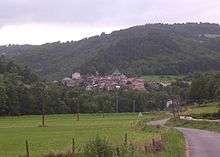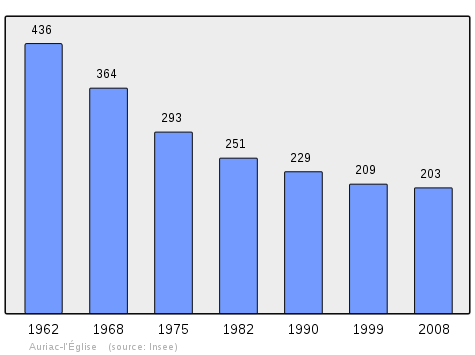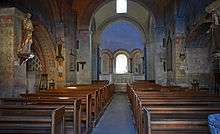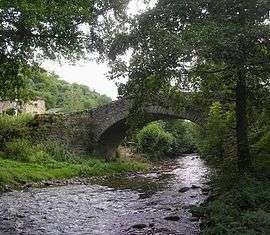Auriac-l'Église
| Auriac-l'Église | |
|---|---|
|
The Sianne river | |
 Auriac-l'Église | |
|
Location within Auvergne-Rhône-Alpes region  Auriac-l'Église | |
| Coordinates: 45°15′55″N 3°07′39″E / 45.2653°N 3.1275°ECoordinates: 45°15′55″N 3°07′39″E / 45.2653°N 3.1275°E | |
| Country | France |
| Region | Auvergne-Rhône-Alpes |
| Department | Cantal |
| Arrondissement | Saint-Flour |
| Canton | Massiac |
| Intercommunality | Pays de Massiac |
| Government | |
| • Mayor (2014–2020) | Vivien Batifoulier |
| Area1 | 19.73 km2 (7.62 sq mi) |
| Population (2010)2 | 205 |
| • Density | 10/km2 (27/sq mi) |
| Time zone | CET (UTC+1) |
| • Summer (DST) | CEST (UTC+2) |
| INSEE/Postal code | 15013 / 15500 |
| Elevation |
539–1,010 m (1,768–3,314 ft) (avg. 650 m or 2,130 ft) |
|
1 French Land Register data, which excludes lakes, ponds, glaciers > 1 km² (0.386 sq mi or 247 acres) and river estuaries. 2 Population without double counting: residents of multiple communes (e.g., students and military personnel) only counted once. | |
Auriac-l'Église is a French commune in the Cantal department in the Auvergne region of south-central France.
Gerography
Auriac-l'Église is located in the Sianne valley east of the Cézallier mountains some 20 km west of Brioude and 7 km north-west of Massiac. The northern and north-eastern border of the commune is also the border between Cantal and Haute-Loire departments. Access to the commune is by road D9 from Allanche in the south-west which passes through the north of the commune just north of the village and continues north, changing to road D20 at the border. The D21 comes from Massiac in the east changing to the D55 at the border and continuing through the village west to join the D9 west of the commune. The D355 goes south from the village to join the D21 which forms the southern border of the commune. Apart from the village there are the hamlets of Alagnon, Serre, Auriac Bas, and Chaselles. The commune is mixed forest on the slopes and farmland on the plain.[1]
The Sianne river flows through the commune from south-west to north-east before it continues north to join the Alagnon west of Servières. Many tributaries join the Sianne in the commune including the Ruisseau de l'Église, the Ruisseau des Rifs, the Ruisseau de la Bastide, the Ruisseau de Gargaure, the Ruisseau de Fraissinet, The Ruisseau de Balain, and the Ruisseau de Larbounet.[1]
Neighbouring communes and villages[1]
 |
Laurie | Blesle | Espalem |  |
| Molèdes | |
Saint-Beauzire | ||
| ||||
| | ||||
| Peyrusse | Molompize | Massiac |
History
In 1855 Friar John Rives of the order of Friars of Saint-Viateur founded a communal school.
In 1899 Friar Camille Mizoule, teacher in Auriac-l'Église and author of La Bretagne à Vol d'oiseau (Brittany Bird Flight) (1898) as well as winner of the Muses armoricaines et Vendéennes award, published a book of poetic essays entitled Auvergne and Brittany.
In 1962 Alphonse Vinatié, (1924-2005), a teacher in the Auriac-l'Église public school and an archaeologist, discovered one of the largest necropolii in France: proto-historic burial mounds in Laurie.[2]
Administration
List of Successive Mayors[3]
| From | To | Name | Party | Position |
|---|---|---|---|---|
| 2001 | 2014 | André Glaize | ||
| 2014 | 2020 | Vivien Batifoulier |
(Not all data is known)
Demography
In 2010 the commune had 205 inhabitants. The evolution of the number of inhabitants is known from the population censuses conducted in the commune since 1793. From the 21st century, a census of communes with fewer than 10,000 inhabitants is held every five years, unlike larger towns that have a sample survey every year.[Note 1]
| 1793 | 1800 | 1806 | 1821 | 1831 | 1836 | 1841 | 1846 | 1851 |
|---|---|---|---|---|---|---|---|---|
| 894 | 675 | 995 | 1,184 | 1,007 | 1,060 | 889 | 928 | 900 |
| 1856 | 1861 | 1866 | 1872 | 1876 | 1881 | 1886 | 1891 | 1896 |
|---|---|---|---|---|---|---|---|---|
| 848 | 808 | 777 | 730 | 748 | 722 | 769 | 770 | 724 |
| 1901 | 1906 | 1911 | 1921 | 1926 | 1931 | 1936 | 1946 | 1954 |
|---|---|---|---|---|---|---|---|---|
| 712 | 680 | 642 | 537 | 541 | 541 | 570 | 513 | 503 |
| 1962 | 1968 | 1975 | 1982 | 1990 | 1999 | 2006 | 2010 | - |
|---|---|---|---|---|---|---|---|---|
| 436 | 364 | 293 | 251 | 229 | 209 | - | 205 | - |
Sources : Ldh/EHESS/Cassini until 1962, INSEE database from 1968 (population without double counting and municipal population from 2006)


Culture and heritage
Civil heritage
- The Motte-and-bailey castle of Chavagnac
- The Dry stone terraces dating from the 19th century, they are located along the edge of the commune and are the remains of the former wine culture. They are called in the local language Pailhas.[4]
- The Château de la Gironde, the remains from the 14th and 18th centuries.
- The Fortified Chateau of Pouzac, a ruined fortified chateau.
- The Old antimony mine, galleries at Riol hamlet.
- Old Houses
- Old ovens, one in the hamlet of Chazelles (demolished in 2002); one in the hamlet of Serre.
- Old Dovecote.
- Mills at Riol and Croze. In 1816 Father Jean-Baptiste Vigouroux (1816-1898) was born in the Riol Mill. He founded the first Catholic mission in New Caledonia in 1851 and, on 24 August 1853, signed the act of possession by France of New Caledonia.
- Gallo-Roman-style Bridge on the Sianne, built in 1897 at Vernède to access 7 properties.
- Sianne Camping ground, the municipal campground with 30 spots located next to the river: 0.76 hectares, 1 star.
Religious heritage


- The Church of Saint Nicolas (12th century)
 [5] is registered as an historical monument.
[5] is registered as an historical monument. - A Cross in the Church Square, placed there in 1899.
Village life
- The Activity and Cultural Committee of Auriac-l’Église (CAC)
Notable people linked to the commune
- Jean-Baptiste Vigouroux (1816-1898), ordained a priest in 1842, he joined the order of Marist missionaries in 1848. He founded the first Catholic mission in New Caledonia in 1851 and signed the act of possession for France of New Caledonia on 24 August 1853. Author of plans for the new small seminary of Saint-Flour. He died at Saint-Louis (New Caledonia) in 1898.[6]
- Alphonse Vinatié (1924-2005). He was a teacher and amateur archaeologist. He conducted numerous excavations in northern Cantal and discovered several archaeological sites. A street in Auriac bears his name. He was a teacher in Auriac-l'Église from 1950 to 1963.
See also
Bibliography
- Our Auvergne ancestors, Auvergne immigration to Brittany, Serge Duigou, Éditions Ressac, Quimper, 2004. (French) [on the subject of the migratory movement from the Cézallier region towards Brittany in the 18th and 19th centuries - notably Auriac with Andraud, Bourse, Boyé, etc.]
External links
- Community of communes of Pays de Massiac official website (French)
- Auriac-l'Église on the old IGN website (French)
- Auriac-l'Église on Lion1906
- Auriac-l'Église on Google Maps
- Auriac-l'Église on Géoportail, National Geographic Institute (IGN) website (French)
- Auriac-l'Église on the 1750 Cassini Map
- Auriac-l'Église on the INSEE website (French)
- INSEE (French)
Notes and references
Notes
- ↑ At the beginning of the 21st century, the methods of identification have been modified by Law No. 2002-276 of 27 February 2002, the so-called "law of local democracy" and in particular Title V "census operations" allows, after a transitional period running from 2004 to 2008, the annual publication of the legal population of the different French administrative districts. For communes with a population greater than 10,000 inhabitants, a sample survey is conducted annually, the entire territory of these communes is taken into account at the end of the period of five years. The first "legal population" after 1999 under this new law came into force on 1 January 2009 and was based on the census of 2006.
References
- 1 2 3 Google Maps
- ↑ J.-P. Daugas, The Necropolis of the Plateau of Laurie, p. 215, The most beautiful archaeological sites in France, éditions Eclectis. (French)
- ↑ List of Mayors of France (French)
- ↑ Roofs, towers, bell towers... tall heritage, Petit journal du patrimoine, by the 5th year class of Blesle. (French)
- ↑ Ministry of Culture, Mérimée PA00093447 Church of Saint Nicolas (French)
- ↑ Letters from Marist missionaries in Oceania, 1836-1854, page 726, Charles Girard collection, Mémoire d'Église, éditions Karthala (French)
| Wikimedia Commons has media related to Auriac-l'Église. |
